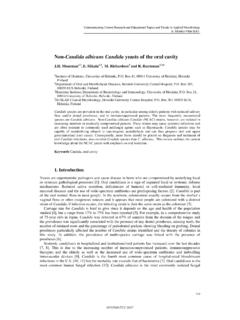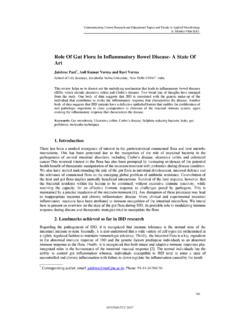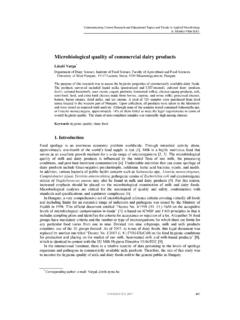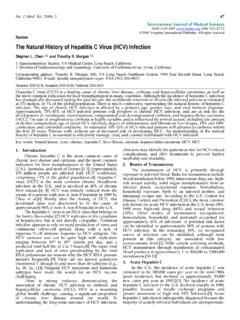Transcription of HUMAN PAPILLOMAVIRUS INFECTION AND CERVICAL …
1 Communicating Current Research and Educational Topics and Trends in Applied Microbiology A. M ndez-Vilas (Ed.). _____. HUMAN PAPILLOMAVIRUS INFECTION AND CERVICAL . cancer : PATHOGENESIS AND EPIDEMIOLOGY. Daniel Tena G mez1 and Juana L pez Santos2. 1. Section of Microbiology. 2 Service of Clinical Analysis. University Hospital of Guadalajara. C/. Donante de sangre s/n. 19003. Guadalajara. Spain. HUMAN PAPILLOMAVIRUS (HPV) is one of the most common causes of sexually transmitted disease in both men and women worldwide. HPV is associated with a variety of clinical conditions that range from innocuous lesions to cancer . Genital HPV types are divided into high and low-risk types, according to the oncogenic potential. Molecular and epidemiologic studies have solidified the association between high- risk HPV types (especially HPV-16 and HPV-18) and CERVICAL squamous cell carcinoma.
2 HPV INFECTION is often transient and self-limiting but uncommonly, INFECTION persists and progress to high grade lesions and cancer . In addition to persistent high-risk HPV INFECTION , other viral factors such as high viral loads, HPV. variants, infections with multiple high-risk HPV types and genetic predisposition contribute to the development of CERVICAL cancer . Although HPV is the primary etiologic agent of CERVICAL cancer , it is not sufficient, and a variety of factors contribute to the cancer development. Risk factors include various aspects of sexual behavior ( number of sexual partners, age of first sexual activity), smoking, long- term oral contraceptive use, immunosuppression, and presence of other sexually transmitted agents. Keywords: HUMAN PAPILLOMAVIRUS ; CERVICAL cancer ; CERVICAL squamous cell carcinoma; CERVICAL intraepithelial neoplasia; Pathogenesis; Epidemiology.
3 INTRODUCTION. PAPILLOMAVIRUS are ubiquitous and have been detected in a wide variety of animals as well as in humans. More than 200 types of HUMAN PAPILLOMAVIRUS (HPV) have been recognized on the basis of DNA. sequence. Specific types of HPV tend to show some tissue tropism, and depending on the type of epithelium infected, HPV types are often referred to as cutaneous or mucosal types. In general, cutaneous types infect the keratinizing epithelium (especially the skin of the hands and feet), while mucosal types infect nonkeratinizing epithelium, primarily the anogenital tract epithelium, though they can also be found in the oral mucosa, conjunctiva and respiratory tract [1]. HPV is associated with a variety of clinical conditions that range from innocuous lesions to cancer (Table 1) [1]. Most HPV infections are benign. INFECTION of cutaneous epithelium can cause warts (plantar warts, common warts and flat warts).
4 Skin warts are transmitted by direct contact with an infected tissue or indirectly by contact with virus-contaminated objects. In general, they resolve spontaneously within 1 to 5 years. Epidermodysplasia verruciformis, a rare genetic disease with HPV- associated warts on the trunk and upper extremities, can develop into invasive squamous cell carcinoma. Recurrent respiratory papillomatosis is primarily a disease of the larynx in young children but can also occur in adults. The INFECTION in young children is thought to be acquired by passage through an infected birth canal. Respiratory tract lesions may undergo malignant transformation. Focal epithelial hyperplasia of the oral cavity (Heck s disease) tends to regress spontaneously. Conjunctival papillomas associated with HPV have been described. HPV-6 and HPV-11 are the etiologic agents of external anogenital warts (condylomas), which occur in sexually active individuals.
5 Although they are benign, genital warts are a significant problem in sexually active populations. Anogenital cancers are the most important diseases associated with HPV infections .. Corresponding author: e-mail: +34-949-209236. Fax: +34-949-209213. 680. FORMATEX 2007. Communicating Current Research and Educational Topics and Trends in Applied Microbiology A. M ndez-Vilas (Ed.). _____. HPV is one of the most common causes of sexually transmitted disease in both men and women worldwide. The incidence of new infections in the United States ranges from 1 million to 5,5 million per year, and the prevalence is estimated to be as high as 20 million [2]. Of the many types of HPV, about 30. infect the genital tract through sexual contact. Genital HPV types infect primarily the cervix, vagina, vulva, penis and anus. These genital-type HPVs are further divided into high and low-risk types, according to the association with genital tract cancer .
6 Low-risk HPV types include types 6, 11, 42, 43, and 44, and usually cause benign anogenital warts. High-risk HPV types include types 16, 18, 31, 33, 34, 35, 39, 45, 51, 52, 56, 58, 59, 66, 68 and 70, and cause anogenital cancer [3]. Among the cancers attributable to high-risk HPV INFECTION , CERVICAL cancer has received the most attention. HPV-16, -18, - 31, -45 account for more than 90% of CERVICAL carcinomas [3]. Of these types, HPV-16 is the most often found, accounting for about half of the CERVICAL cancer cases in the United States and Europe [3]. In addition, high-risk HPV types have been related with other genital cancers, such as carcinoma of vagina, vulva, penis and anus, and their precancerous lesions [4]. Table 1. HUMAN PAPILLOMAVIRUS types and clinical manifestationsa. Clinical manifestations HPV typeb Plantar warts 1, 2, 4, 63.
7 Common warts 2, 1, 7, 4, 26, 27, 29, 41, 57, 65, 77, 3, 10, 28. Flat warts 3, 10, 26, 27, 28, 38, 41, 49, 75, 76. Other cutaneous lesions ( , epidermoid cysts, 6, 11, 16, 30, 33, 36, 37, 38, 41, 48, 60, 72, 73. laryngeal carcinoma). 2, 3, 10, 5, 8, 9, 12, 14, 15, 17, 19, 20, 21, 22, 23, Epidermodysplasia verruciformis 24, 25, 36, 37, 38, 47, 50. Recurrent respiratory papillomatosis 6, 11. Focal epithelial hyperplasia de Heck 13, 22. Conjunctival papillomas/carcinomas 6, 11, 16. Genital warts (condyloma acuminatum) 6, 11, 30, 42, 43, 45, 51, 54, 55, 70. Low-risk CERVICAL intraepithelial neoplasia 6, 11, 16, 18, 31, 33, 42, 43, 44, 45, 51, 52, 74. 16, 18, 6, 11, 31, 34, 33, 35, 39, 42, 44, 45, 51, High-risk CERVICAL intraepithelial neoplasia 52, 56, 58, 66. 16, 18, 31, 45, 33, 35, 39. 51, 52, 56, 58, 66, 68, CERVICAL carcinoma 70.
8 Other genital carcinomas (vagina, vulva, penis and 16, 18, 31, 45, 33, 35, 39. 51, 52, 56, 58, 66, 68, anus) 70. HPV: HUMAN PAPILLOMAVIRUS . a Data from reference 1. b Order indicates relative frequency; bold type indicates most frequent association. CERVICAL cancer and premalignant lesions constitute a major problem in women s health. CERVICAL cancer is the second most common cancer in women worldwide and is the most frequent cancer in many developing countries. Every year, new cases of CERVICAL cancer are diagnosed worldwide, and 681. FORMATEX 2007. Communicating Current Research and Educational Topics and Trends in Applied Microbiology A. M ndez-Vilas (Ed.). _____. about half of the afflicted women will die [5]. Although CERVICAL screening has dramatically reduced the incidence of this disease in the developed world, it is still estimated that there will be deaths from CERVICAL cancer in the per year [5].
9 In areas of the world where most women do not have access to regular gynecological care and screening, CERVICAL cancer is second only to breast cancer as a cancer - related cause of death [6]. The link between genital HPV infections and CERVICAL cancer was first demonstrated in the early 1980s by Harold zur Hausen, a German virologist. Since then, the link between high-risk HPV types and CERVICAL squamous cell carcinoma has become well known. In 1996, the World Health Association recognized HPV as an important cause of CERVICAL cancer . HPV has been implicated in of CERVICAL squamous cell carcinoma cases worldwide [7]. The magnitude of the association between HPV and CERVICAL carcinoma is higher than that for the association between smoking and lung cancer [8]. Adenocarcinomas of the cervix are also related to HPV (especially HPV-18), but the correlation is less pronounced and is age dependent.
10 In women younger than 40 years, HPV was present in 89% of adenocarcinomas, whereas in women aged 60 years and older, HPV was observed in only 43% [9]. VIROLOGY. Papillomaviruses are members of the Papovaviridae family. HPV is a small, nonenveloped virus, with a diameter of 55nm. It has an icosahedral capsid composed of 72 capsomers, which contain at least two capsid proteins, L1 (major) and L2 (minor). Each capsomer is a pentamer of the major capsid protein. Each virion capsid contains several copies (about 12 per virion) of the minor capsid protein. The HPV. genome consists of a single molecule of double-stranded, circular DNA containing approximately bp associated with histones [10]. The genome is functionally divided into three regions. The first is a noncoding upstream regulatory region (URR). This region contains the p97 core promoter along with enhancer and silencer sequences that regulate DNA replication by controlling the transcription of the early and late regions.














